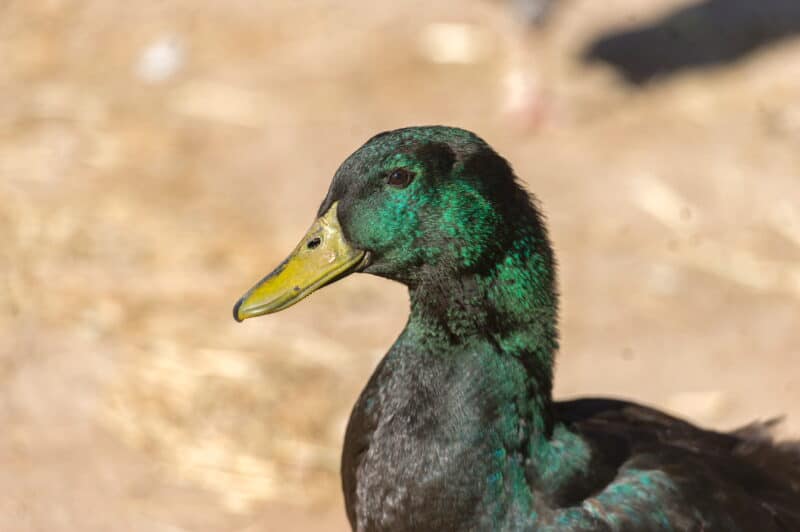Cayuga ducks are one of the most iconic, instantly recognizable, and beautiful domestic duck breeds in the world. They are quiet, gorgeous, highly productive, and undeniably beautiful with their rippling, iridescent blue-green feathers.

Sadly, this breed has been close to extinction more than once, but luckily they are making a comeback thanks to a surge of renewed interest from hatcheries and backyard owners and homesteaders.
Anybody would be proud to own these magnificent birds, but if you want a flock to call your own there are some things we’ve got to know. For starters, can Cayugas actually fly, and if they can, how far?
No, Cayugas cannot fly as a rule. These are hefty ducks with poorly developed flight muscles and nearly all cannot achieve true flight. They can take flapping leaps, though, that can allow them to clear short obstacles. Note that some small and exceptional individuals might be able to achieve limited flight.
Basically, you don’t have to worry about your Cayugas literally flying the coop on you. They are simply too heavy and, like most domestic ducks, lack the musculature needed to attain liftoff and keep themselves in the air.
That’s good news for any backyard keeper, but that doesn’t mean you don’t need a fence for them. Keep reading, and I’ll tell you everything else you need to know and this regard about Cayugas.
Cayuga’s Can’t Really Fly, But They Can Jump a Bit
Cayuga’s are considered to be genuinely flightless like most other domestic ducks. They tend to be too heavy, and their muscles too poorly developed to get them into the air.
Plus, considering the overall lack of exercise that most backyard ducks get and the high-calorie diet that they]re fed, even average weight gain is likely to keep them completely grounded.
However, their wings and feathers still work to provide a certain amount of lift, and Cayugas might try to take to wing in long, flapping leaps to cover more ground quickly, to clear obstacles ,or to attempt escape from an enclosure.
They are especially likely to do this if they are traveling downhill or, for whatever reason, on a high perch.
Because of this, it’s always in your best interest to make sure that they can get down safely from wherever they are because they can still get injured, and you also must make sure your fences are tall and strong enough to contain them. Short fences won’t keep them where they belong!

How High Should Fences Be to Contain Cayugas?
At the very least, I recommend a 4-foot (1.2 meters) fence as long as there are no obstacles nearby that Cayugas could use to climb up and then jump over.
This is probably more than enough for keeping your flock in place and preventing escape attempts, you must keep in mind that the flight abilities of all ducks, including these, are somewhat individual to a degree.
Exceptional jumpers or flyers in your flock might be able to leap over a 4-foot fence with no problems.
When in doubt, err on the side of a taller fence for maximum security.
Some Smaller Cayugas Might be Capable of Limited but True Flight!
You don’t have to look very far on the internet to find stories of owners who, secure in the assurances that their ducks or flightless, came out one day to find them gone or to see their ducks flying out or flying back to their property. It’s hilarious to read about, yes, but it’s shocking and upsetting if it happens to you!
You know how the old saying goes; never say never. And though I can tell you, with high confidence, that Cayugas are indeed flightless, as a rule of thumb, it rarely fails that there will be a few exceptional ducks now and then to prove you wrong.
Especially if you have a Cayuga that is very small by the standards of the breed, let’s say under 6 pounds by a little bit, chances are good it will be able to take flight if only for a limited time.
Even short flights can help them escape and put a lot of distance between you and them, or get up into places where they just shouldn’t be.
Make sure you always do that headcount at the end of the day, and if you have any concerns you need to take action to prevent escape.
If you Have Any Doubts on Your Flock’s Flightiness, Clip Their Wings
As with all domestic ducks, if they are proving to be a little flightier than you bargained for, or if their wings give their jumps just enough extra thrust to clear the fence, you need to clip them.
Clipping a duck’s wings is not harmful, and it doesn’t maim. It’s just trimming back those primary flight feathers to eliminate the lift that the wings provide. Done properly, it won’t even hurt them! You can learn to do this yourself with the right tools or have a vet do it.
I wouldn’t expect your Cayugas will need it, but like I said, you just never know!
Tom has lived and worked on farms and homesteads from the Carolinas to Kentucky and beyond. He is passionate about helping people prepare for tough times by embracing lifestyles of self-sufficiency.
